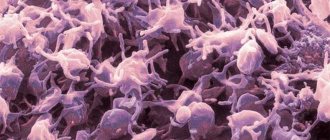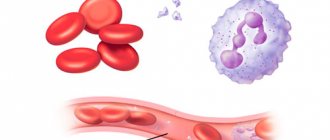General information
A condition called thrombocytopenia is characterized by a decrease in the number of platelets in the blood to less than 150 x 109/L. As a result, the patient experiences increased bleeding and difficulty stopping the bleeding . Thrombocytopenia (ICD-10 code - D69.6 Thrombocytopenia, unspecified) may accompany hematological diseases. However, an independent disease is also diagnosed - idiopathic thrombocytopenic purpura (ICD-10 code - D69.3), as well as an autoimmune form of the disease.
Speaking about thrombocytopenia - what kind of disease it is, it should be noted that it develops as a result of a disruption in the production of platelets or too active destruction of them. The autoimmune form of the disease is most often diagnosed. This condition can also develop against the background of a number of diseases: herpes , hepatitis , HIV, infectious mononucleosis , influenza . It can also be provoked by some exogenous factors. What thrombocytopenia is, the causes and treatment of this disease are described in detail in this article.
What are platelets needed for?
Platelets (blood platelets) are one of three types of blood cells (the other two types are leukocytes and erythrocytes). They are often called blood cells, but in fact they are not such, but are detached fragments of megakaryocytes - a special type of giant cells that are found in the red bone marrow.
Some facts about platelets:
- The two main properties of blood platelets are the ability to adhere and bond. Due to this, platelets form a plug that blocks the lumen of the vessel when it is damaged.
- In addition, platelets secrete active substances that take part in the process of blood clotting and subsequent destruction of the blood clot.
- The normal size of blood platelets is 1–4 micrometers.
- On average, a platelet lives for 8 days.
The normal level of platelets in the blood is 150–300*109 per liter. Thrombocytopenia is a condition in which this indicator is less.
Pathogenesis
Platelets are blood cells that are produced in the bone marrow. They live in the body for a little more than a week, after which they disintegrate in the spleen and liver. The main functions of these cells in the body are to prevent the development of bleeding. The cells stick together and a blood clot forms, blocking the wounded vessel. In addition, they determine the synthesis of growth factors that affect tissue repair processes. Platelet levels may fluctuate depending on certain factors. However, such fluctuations are physiological and temporary. Normally, the level of these cells is 150 thousand per microliter (150 x 109/l). If the platelet count decreases, we are talking about thrombocytopenia.
Currently, the pathogenesis of this disease has not been sufficiently studied.
The mechanism of development of the disease may be associated with the following factors:
- impaired platelet production by the bone marrow;
- disruption of their distribution in the vascular bed;
- platelet deficiency and increased destruction.
Idiopathic thrombocytopenic purpura develops due to an autoimmune reaction that is directed against one’s own platelets. This immune reaction is a complex cyclic process in which B lymphocytes, T lymphocytes, macrophages , NK cells, and cytokines participate. Antibodies to platelets are not always detected in the blood.
In children, the development of ITP often occurs after acute respiratory viral infections. When the platelet count falls below 10 x 109/L, the bleeding period prolongs.
How does thrombocytopenia manifest?
What is low platelet count
Platelets are colorless spherical blood cells that are synthesized in the bone marrow. These elements live for 12 days, are responsible for the process of regeneration and coagulation, the elasticity of blood vessels, and carry nutrients.
A decrease or increase in quantity negatively affects the course of pregnancy and fetal development.
Acceptable standards:
- I trimester – 170-340 thousand/µl;
- II – 160-330 thousand/µl;
- III – 140-320 thousand/µl.
The number of platelet components shows the CBC. If the values are below the acceptable limit, thrombocytopenia is diagnosed.
Classification
The disease is divided according to several characteristics. Taking into account the origin, it is determined:
- Primary thrombocytopenia - development is associated with a violation of hematopoietic processes, the production of antibodies in the body that destroy platelets.
- Secondary thrombocytopenia develops against the background of other diseases. The secondary form of the disease can also be the result of serious poisoning, radiation, or alcoholism.
The types of thrombocytopenia are determined by:
- Immune thrombocytopenia - this condition develops if the immune system begins to perceive platelets as foreign agents. As a result, immune thrombocytopenia leads to the destruction of platelets by the body's immune system.
- Essential thrombocytopenia - this form of the disease most often affects older people, after 50 years. The essential form often develops after surgical operations, as well as against the background of chronic diseases of internal organs and iron deficiency.
- Idiopathic thrombocytopenic purpura is most often diagnosed in children. The disease is associated with blood clotting disorders.
- Thrombocytopenia in newborns can accompany congenital pathological conditions, and also develop as a secondary disease during asphyxia during childbirth, infection of the child, etc.
Taking into account the severity of the disease, it is determined:
- Easy . The platelet level is the lower limit of normal (30-50 x 109/l), symptoms of pathology do not appear. Sometimes nosebleeds occur. As a rule, this condition is determined by chance, during preventive tests. In this case, no treatment is required; the doctor monitors the patient’s condition.
- Average. The platelet level is reduced (20-50 x 109/l). There are hemorrhages under the skin, even with minor blows noticeable hematomas occur, and frequent nosebleeds are a concern. Small rashes may appear on the body. Treatment of the condition is carried out if there is a threat of internal bleeding.
- Heavy. The platelet level is very low, sometimes critical (less than 20 x 109/l). Extensive internal bleeding and multiple skin rashes develop. Treatment is mandatory and the patient should be hospitalized.
Based on the nature of the disorders, the following forms of thrombocytopenia are distinguished:
- isoimmune;
- transimmune;
- heteroimmune;
- autoimmune.
The nature of the flow determines:
- acute (up to six months);
- chronic:
- with rare relapses;
- continuously relapsing.
Symptoms of the disease
The clinical picture of the disease manifests itself when platelets decrease to 50,000 per μl of blood. The norm for an adult is 150,000 per microliter. Thrombocytopenia of various forms manifests itself in the body as follows:
- The appearance of subcutaneous hematomas and hemorrhages with a slight blow or pressure on the surface of the body.
- A rash on the body in the form of yellow, blue, red spots.
- Bruising on the eyeball.
- Bleeding of internal organs. In some cases, bleeding occurs in the brain.
- Severe headaches of unknown origin.
- Nosebleeds, increased sensitivity of the gums.
- Enlarged spleen.
- Long menstrual cycle in women, bleeding between cycles.
- Opening bleeding at the site of surgical operations.
All symptoms of thrombocytopenia boil down to the fact that the blood loses its ability to clot, and the walls of blood vessels acquire increased permeability. The blood does not clot due to a disrupted enzyme responsible for connecting the cell to the damaged wall of the vessel or artery. Vessels lose their usual permeability due to the fact that the channels that feed them, which depend on platelets, are disrupted. A reduced level of serotonin in the body has a negative effect. Signs of pathology in some cases look identical to other diseases and disorders in the body. A doctor must diagnose and treat the disease and draw up a clinical protocol after the procedures and tests performed.
Causes of thrombocytopenia
The reasons for the decrease in platelet levels in children and adults are due to the fact that they are being destroyed too actively, or an insufficient number of them is formed in the body.
The following conditions can lead to platelet destruction:
- idiopathic thrombocytopenic purpura;
- other autoimmune diseases - lupus erythematosus , rheumatoid arthritis ;
- previous surgical operations ( heart bypass surgery );
- side effects of certain medications;
- preeclampsia in pregnant women.
The causes of thrombocytopenia in adults, leading to decreased platelet production, may be the following:
- viral diseases - hepatitis C , chickenpox , HIV , mononucleosis , etc.;
- oncological diseases – leukemia , lymphoma ;
- bone marrow irradiation;
- chemotherapy;
- alcoholism;
- deficiency of folic acid , vitamin B12 .
Treatment methods for thrombocytopenia
The method of treating the patient is determined by the doctor, based on the stage of the pathology, the dominant, causative disease, and also takes into account the age and well-being of the patient. All therapy methods have the following goals:
- Prevent death.
- Reduce the likelihood of disability.
- Strengthen the patient's physical condition.
- Improve the patient’s quality of life after treatment.
At the initial stage of the disease, a comprehensive therapeutic course is not carried out. The doctor is limited to special recommendations that the patient must follow for lasting satisfactory well-being. Efforts are made to prevent unexpected bleeding.
If the reduced platelet concentration is due to medication, the doctor will prescribe a different drug or change the medication regimen. In some cases, a specially developed drug for blood clotting is prescribed. In autoimmune pathology, when the immune system blocks platelets, medications are prescribed that suppress these body reactions. The patient is injected intravenously with immunoglobulin - a solution of blood serum to normalize platelets. Plasmapheresis often helps normalize the patient's condition. Dexamethasone is also prescribed to strengthen the immune system and normalize blood functions.
Treatment of severe stage of the disease
To improve the physical condition of a patient with a severe form of pathology, the following methods are used:
- Medications. If necessary, your doctor will prescribe steroids to slow platelet breakdown. Immunoglobulins are also used to normalize the immune response.
- Transfusion of blood or blood substitutes. It is used for heavy blood loss to replenish the volume of fluid in the body.
- Splenectomy. Surgical removal of the spleen. It is used when drug treatment is unsuccessful.
The treatment method is determined by the attending physician. Self-medication can lead to complications. The danger of the disease is sometimes irreversible.
Symptoms
Thrombocytopenia in adults is manifested by a number of symptoms that depend on the severity of the disease. Signs may be as follows:
- the appearance of spontaneous hemorrhages in the mucous membranes and under the skin;
- nausea, dizziness ;
- prolonged bleeding after tooth extraction;
- increasing the period of bleeding cessation;
- spontaneous appearance of hematomas in different parts of the body;
- severe drowsiness , loss of strength;
- increased nosebleeds;
- very heavy periods.
Speaking about what thrombocytopenia is in adults, it should be noted that the results of a blood test for thrombocytopenia show from 0 to 50 per 10 in 9 platelets / l.
How dangerous is the disease and who is at risk?
The causes of the disease depend on the pathological processes occurring in the body:
- Platelet deficiency in the bone marrow. It is observed in aplastic and megablastic anemia, metastasis of malignant tumors into the body of the red brain, acute and chronic leukemia, and viral invasion. It can be a consequence of taking medications and a course of radiation therapy.
- Massive bleeding or increased platelet destruction.
- Impaired distribution of platelets or their excessive deposition.
- Excessive rate of destruction of blood plaques and attenuation of compensatory mechanisms.
- Anomalies in the development of the skeletal system.
The mechanics of the development of the disease are identical for all cases - the concentration of platelets decreases, which provokes disturbances in the nutrition of the capillary walls, and this leads to their excessive fragility.
The result is spontaneous or traumatic bleeding due to rupture of small vessels. Since the platelet count is low, a platelet plug does not appear inside the damaged vessel, and this causes a massive release of blood outside the vessel into the surrounding tissue.
The greatest danger for the patient is the fact that a decrease in platelets to 100x10 in 9 g/l is asymptomatic (at a normal level of 180-320x10 in 9 g/l). A person feels quite comfortable, but at the same time life-threatening conditions, for example, anemia, are already developing in his body.
The prognosis for the outcome of the disease is determined by several factors:
- severity of clinical symptoms and duration of the disease;
- presence of complications;
- timeliness and correctness of treatment;
- the severity of the underlying disease.
All patients undergoing treatment for thrombocytopenia should undergo a complete blood count every 6 months for preventive purposes.
Thrombocytopenia is insidious with sudden relapses. Against the background of complete well-being, a sharp drop in platelets is possible. This is mainly characteristic of thrombocytopenia in blood diseases. Such patients, in addition to laboratory monitoring, require self-monitoring. Even slight bleeding of the gums should alert you. In this case, you do not need to undergo a scheduled examination; you must immediately make an appointment.
Tests and diagnostics
The main test to determine thrombocytopenia is a clinical blood test that determines platelet levels.
If, based on the test results, the patient is diagnosed with congenital thrombocytopenia , a bone marrow examination is performed. megakaryocytes is determined . If they are absent, this indicates a disruption in the process of platelet formation, if they were present - we are talking about the deposition of platelets in the spleen or their peripheral destruction.
To determine the causes of the development of pathology, the doctor may prescribe the following studies:
- antibody tests;
- genetic tests;
- Ultrasound;
- electrocardiogram;
- endoscopic examination;
- radiography.
Diagnostics
Diagnosis of pathology is carried out on the basis of clinical studies of urine, plasma, and cerebrospinal fluid.
What tests are prescribed:
- blood test to determine the level of coagulation, detection of antibodies to platelet elements;
- general and biochemical blood test to assess the number of leukocytes, erythrocytes, platelets;
- urine test for hemosiderin - an iron-containing pigment formed during the breakdown of blood;
- aspiration puncture.
Additionally, an ultrasound is prescribed to study the condition of the spleen and kidneys.
Treatment with folk remedies
If the treatment of thrombocytopenia is carried out according to the regimen prescribed by the doctor, then after consultation with a specialist, you can try to improve the general condition of the body using folk remedies. However, it is important to understand that treatment of thrombocytopenia with folk remedies should under no circumstances replace therapy prescribed by a doctor.
You can use the following traditional methods:
- Verbena infusion. Pour 5 g of verbena into a glass of boiling water. Leave for half an hour. Drink a glass every day for a month.
- Sesame oil. Every day you should consume 10 g of oil, adding it to a salad or consuming it separately from food.
- Stinging nettle. Pour 10 g of dry raw material into a glass of boiling water and boil for 10 minutes. Drink 20 ml 3 times a day.
- Burnet decoction. An effective remedy for stopping bleeding. 2 tbsp. l. pour the product into a glass of water and boil for 15 minutes. After 3 hours, strain, drink 20 minutes before meals, 3 tbsp. l.
- Herbal collection. Mix 30 g of yarrow flowers and shepherd's purse. 1 tbsp. l. Pour 0.5 liters of boiling water over this mixture and leave for several hours. Drink half a glass three times a day before meals.
- Rose hip decoction. Pour 50 g of rose hips into 0.5 liters of water and cook for 5 minutes. Pour into a thermos and leave overnight. Drink instead of tea, adding honey.
- Viburnum bark. 2 tbsp. l. dry raw materials, pour 300 ml of water, cook for half an hour. Strain and add water to get the original volume. Drink 4 times a day, 2 tbsp. l.
- Dried fruits. It is necessary to chop 200 g of dried apricots, figs, raisins, and prunes. Add 200 g of honey and the juice of 2 lemons to the mixture. Place the mixture in small jars and store them in the refrigerator. In the morning, take 1 tbsp. l. facilities.
- Beetroot juice. Mix fresh beet juice with equal amounts of cucumber and carrot juice. Take a glass of this remedy in the morning, then have breakfast an hour later.
In children
When discussing the treatment and causes of thrombocytopenia in children, it should be noted that this condition can be congenital, accompanying pathologies in newborns. Thrombocytopenia may also be a secondary disease. The reasons for this are related to infection of the child, premature birth or asphyxia during childbirth.
The causes of thrombocytopenia in children depend on the form of the disease.
- Idiopathic thrombocytopenic purpura develops with a frequency of 3-5 cases per 100 thousand children. Most often diagnosed in school-age children. Most often it manifests itself in children who have recently suffered a viral disease - mumps , measles , chickenpox , rubella , etc.
- Secondary thrombocytopenia can develop against the background of certain diseases ( hepatitis , cytomegalovirus infection ), taking a number of medications ( Heparin , Abciximab , etc.).
In order to recognize the disease in a child in time, parents should pay attention to the characteristic manifestations of the disease. In this condition, bleeding develops - pinpoint hemorrhages appear on the skin, frequent nosebleeds, gum bleeding, and gastrointestinal bleeding are disturbing. It is important to understand that internal bleeding can threaten the baby's life.
If the diagnosis has been confirmed through research, it is important to properly treat thrombocytopenia in children. His regimen is prescribed by a doctor.
Treatment is prescribed if the platelet count is less than 20-30 thousand per microliter. But most often, the doctor is guided by the presence of pronounced clinical manifestations before prescribing a treatment regimen. The specialist may prescribe corticosteroids ( Prednisolone , Dexamethasone ). In severe cases, cytostatics ( Vincristine , Vinblastine ) and immunosuppressants ( Azathioprine , Cyclosporine ) are prescribed. In rare cases, the spleen is removed.
But most often, the platelet count in children becomes normal over time on its own, without treatment. According to statistics, in 60% of children the condition returns to normal after a month and a half, in 80% of children - after 6 months.
But in any case, over a certain period it is necessary to visit a doctor and conduct control blood tests.
In addition, parents must adhere to some important rules to protect their baby:
- It is important that the child does not engage in activities that could cause injury. He should not engage in traumatic sports.
- You should choose your toothbrush carefully - it should be soft.
- In some cases, it is advisable to take laxatives to avoid intestinal trauma.
- Do not use medications that increase bleeding ( Aspirin ).
- Provide hospitalization of the child in case of bleeding, in the presence of severe hemorrhages in the mucous membranes and skin.
Parents should be aware that the most serious complication of thrombocytopenia is cerebral hemorrhage. It develops if the platelet count is 10-20 thousand per microliter. Symptoms that should be alarming are a sharp bursting headache , convulsions , vomiting, and facial asymmetry. If such signs occur, you should immediately call an ambulance. However, such complications rarely develop.
Thrombocytopenia during pregnancy
Pregnant women may experience a decrease in platelet counts and hemocoagulation changes. Thrombocytopenia during pregnancy can be a consequence of both physiological and pathological processes. Normally, in most expectant mothers, the platelet count decreases by 10% compared to normal levels. The most significant decrease in platelets during pregnancy is observed in the last trimester.
If severe thrombocytopenia develops, this is manifested by a loss of strength and the formation of hematomas on the skin and mucous membranes.
Specific conditions associated with pregnancy are:
- Gestational thrombocytopenia - the platelet count may decrease to 43x109/L. Develops at the end of the second to the beginning of the third trimester. It is a physiological condition that does not complicate pregnancy.
- Thrombocytopenia in a hypertensive state – these conditions include preeclampsia and HELLP syndrome. These conditions require treatment, as they threaten the normal course of pregnancy.
To prevent complications, a pregnant woman should regularly take blood tests, eat right and follow all doctor’s recommendations.
Medical therapy
Treatment depends on the severity of the condition and is aimed at eliminating the cause. Mild cases require no medical treatment but require regular monitoring. Severe illnesses such as preeclampsia require medical treatment.
Treatments include:
- Taking corticosteroids, which quickly increase platelet counts and reduce the risk of bleeding.
- Immunoglobulin injections. They increase the number of platelets.
- Transfusion, when a mass of blood elements is transfused. This is rarely done.
- Rinse with aminocaproic acid for excessive bleeding from the oral mucosa.
- If none of the above treatment methods helps, splenectomy, removal of the spleen. The operation is performed in the second trimester in rare cases.
How to raise platelet levels during pregnancy without drugs
Natural remedies increase platelet levels in the blood without the use of drugs, possibly in mild cases of the disease:
- You need to eat more fruits and vegetables: oranges, kiwis, tomatoes and green leafy vegetables. They strengthen the immune system and prevent the development of thrombocytopenia.
- It is necessary to drink freshly prepared juices from beets and carrots. Juices improve platelet levels in the blood.
- Include foods rich in vitamin C in your diet: spinach, lemon, bell pepper and broccoli.
- There are freshly prepared pickled gooseberries or jam. This will cleanse the blood.
- Foods containing omega-3 fatty acids boost immunity and naturally increase platelet levels. Pregnant women with thrombocytopenia are recommended to eat eggs, fish, flaxseed oil, tuna and salmon.
- Whole grains contain phytoestrogens and vitamin E, which reduce the effect of platelet aggregation in the blood and increase platelet levels.
- Walnuts, boiled carrots, peanuts, black sesame seeds, lean meat and milk also increase platelet counts.
Watch a video on how to raise platelet levels during pregnancy:
Diet
Diet for essential thrombocythemia
- Efficacy: therapeutic effect after 3 weeks
- Timing: constantly
- Cost of products: 1400-1500 rubles per week
People who have a low platelet count in their blood should follow some recommendations when shaping their diet.
- You need to eat meals in small portions, doing this at least 5 times a day.
- The diet should contain protein foods that are easily digestible (liver, poultry, fish).
- It is important to get proteins from plant foods, consuming legumes, nuts, and mushrooms.
- It is recommended to include more fresh vegetables and fruits in the menu. It is better to choose seasonal fruits and steam, boil, or bake vegetables.
- Low-fat dairy products should also be included in your diet every day.
- It is recommended to cook porridge in water from whole grains - buckwheat, rice, wheat.
- It is better to choose bread with bran.
- You should drink weak tea, dried fruit compote, berry fruit drinks, cocoa, and fresh juices.
- You can make an omelet from quail eggs.
Prevention of thrombocytopenia during pregnancy
Preventing pathology is the best way to combat the disease. The main prevention of low platelet levels during pregnancy is dietary correction:
- Adequate consumption of vegetables and berries with a high content of ascorbic acid is necessary - Chinese cabbage, red and black currants, citrus fruits.
- Infusions of rosehip and nettle will help strengthen blood vessels (if the woman has no contraindications to these medications).
- Lemon (necessarily with peel) with honey has a beneficial effect on the composition of the blood and the vascular system as a whole.
Compliance with preventive and therapeutic measures allows you to successfully carry and give birth to a toddler. The prognosis for thrombocytopenia is generally favorable.










